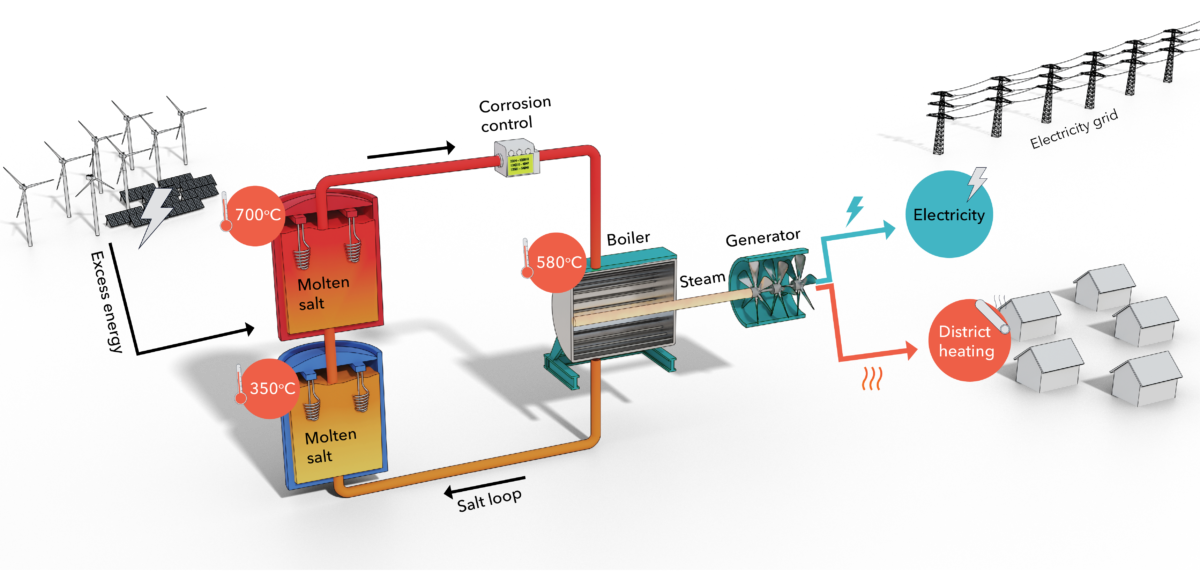Seaborg Technologies, a Danish manufacturer of molten salt nuclear reactors, is working with its sister company, Hyme Energy ApS, to develop a molten salt thermal energy storage technology that can store large amounts of intermittent wind and solar power.
The novel technology was originally conceived for use in Seaborg’s next-generation advanced nuclear reactor, the Compact Molten Salt Reactor. But it acquired a life of its own when the company's experts developed a chemistry control method that holds the corrosion by sodium hydroxide at bay.
“Normally no chemist in their right mind would look at anything as corrosive as sodium hydroxide,” Seaborg CEO, Troels Schönfeldt, told pv magazine. “However, in the development of our reactor, we needed to use sodium hydroxide and were forced to develop these methods.”
Sodium hydroxide can be produced at low cost from seawater as a byproduct from chlorine production. Seaborg said this is six times cheaper that standard salts used for storage.
“Hydroxides can contain more heat per salt unit, making it more efficient and reducing the amount of salt needed compared to current salt uses,” the company explained. “This reduces the cost of salt as a storage medium by approximately 90%”.
Sodium hydroxide is produced across the globe in bulk, as a byproduct part of the alkali chloride process. Normally, bulk price would be around $150 per ton, or around $0.75 per kWh as a volumetric storage price for the storage medium.
The proposed storage system uses renewable energy to heat the salt using electrical heaters. It is based on two-tank molten salt storage designs developed for concentrated solar power (CSP) plants. It has a scalable storage capacity from 250MWh to 5GWh. A 1GWh facility with sodium hydroxides is expected to be able to store heat to produce power and heat for around 100,000 households for 10 hours of discharge.
The two tanks are able to store electricity as heat at 700 C. The high temperature provides large flexibility for how energy can be extracted back out, including Rankine cycle combined heat-and-power production, Brayton cycle heat-to-power, heat storage for district heating, and industrial process heat.
The immersion heaters are used to store excess electricity as heat, while pumps control the flow for discharging through salt to steam heat exchangers for producing steam to drive steam turbines for co-generation in the simplest setup. Seaborg said this storage system may have a maximum heat loss down to 0.5% to 1% per day and its charge and discharge are freely scalable. Its costs should be between 30% and 50% lower than conventional molten salt storage. Hyme believes it could halve the price of long-term and large-scale energy storage facilities regardless of the geographical location.
“We are pursuing the commercialization of hydroxides as the key component in large-scale energy storage,” said Hyme CEO Ask Emil Løvschall-Jensen, noting that the first pilot manufacturing facility should be operational within 18 months.
Hyme has received backing from the Danish Energy Agency to build the pilot plant at a test site in Esbjerg, Denmark – an area well-known as a very favorable geographical site for wind power, with large offshore projects already in operation. The pilot plant will be built by Hyme together with project partners including SAN Electro, Alfa Laval and Sulzer, as well as regional district heating supplier DIN Forsyning.
This content is protected by copyright and may not be reused. If you want to cooperate with us and would like to reuse some of our content, please contact: editors@pv-magazine.com.




I wish to join your community of readers, l found the information very useful
Sodium hydroxide is made from sodium chloride so I doubt the hydroxide is cheaper. However sodium hydroxide has a much lower melting point (322°C) and almost twice the heat capacity of sodium chloride. It is therefore a much better thermal media for storing heat except for it’s extremely corrosive nature.
Instead of electric heaters, wouldn’t it be more efficient to use a heat pump to move heat from the cool tank to the hot one?
> heat pump
That thought crossed my mind – briefly.
It’s all about thermodynamic efficiency. To extract the energy back out of something hot, the efficiency is proportional to the difference between input and output temperatures. So the hotter the salt, the more efficient the energy extraction/recovery.
For a heat pump, the greater the output temperature (the bigger hill you have to push the heat up), the less efficient the process. The heat pump in your home may have an “efficiency” of say 400%, but it’s only pushing the heat up a differential of maybe 20-30’C. A whole different matter for 200, 300, 600’C.
So what you gain on the swing you lose on the roundabout.